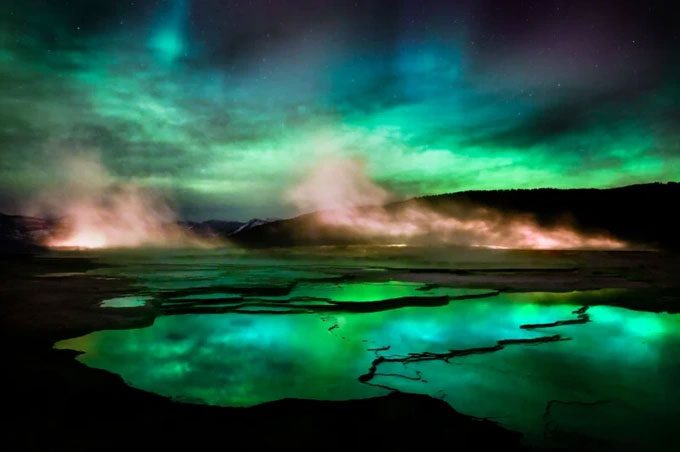The aurora appears in many places around the world due to the influence of a solar storm, creating a magical scenery reminiscent of a mythical film.

The light from the aurora and the lake surface resemble beautiful, colorful ribbons. (Photo: Geoff Coalter).
In astronomy, the aurora is a rare phenomenon, particularly captivating to observers as the sky becomes a colorful display, akin to a mythical film. Many individuals have dedicated time and effort to “hunt” for beautiful photographs of the aurora.
With the solar storm affecting Earth and peaking on May 10, a group of photographers gathered at the White Dome Geyser in Yellowstone National Park, western United States, to witness this stunning moment firsthand.
In the photograph, the geothermal pools serve as the foreground, reflecting and blending with the enchanting lights of the aurora visible in the sky, creating an intriguing combination.
However, this phenomenon only lasted for a few hours before being overshadowed by sunlight. To capture the image, photographer Geoff Coalter shot with an 8-second exposure using a Nikon Z8 in conjunction with a Nikkor Z 24-70 f/2.8 lens.

Aurora observed at Yellowstone National Park, USA. (Photo: Geoff Coalter).
The aurora is an optical phenomenon that occurs when the sky displays colorful light bands at night. Auroras comprise various colors ranging from white, green, blue, to pink and purple, with green and blue being the most common.
The aurora phenomenon occurs in cycles of the sun and typically happens in late autumn and early spring. It is created by the interaction of charged energy particles from the sun with molecules in Earth’s atmosphere.
From a scientific perspective, this phenomenon negatively impacts our planet, specifically by eroding the ozone layer.
An international research team has discovered that the impact of isolated proton auroras creates a gap nearly 400 square kilometers wide in the ozone layer, causing most ozone to disappear within about two hours.
According to scientists’ warnings, occurring auroras can disrupt some active satellites and underground electrical infrastructure. Charged particles also pose a danger to astronauts on missions in space.


















































